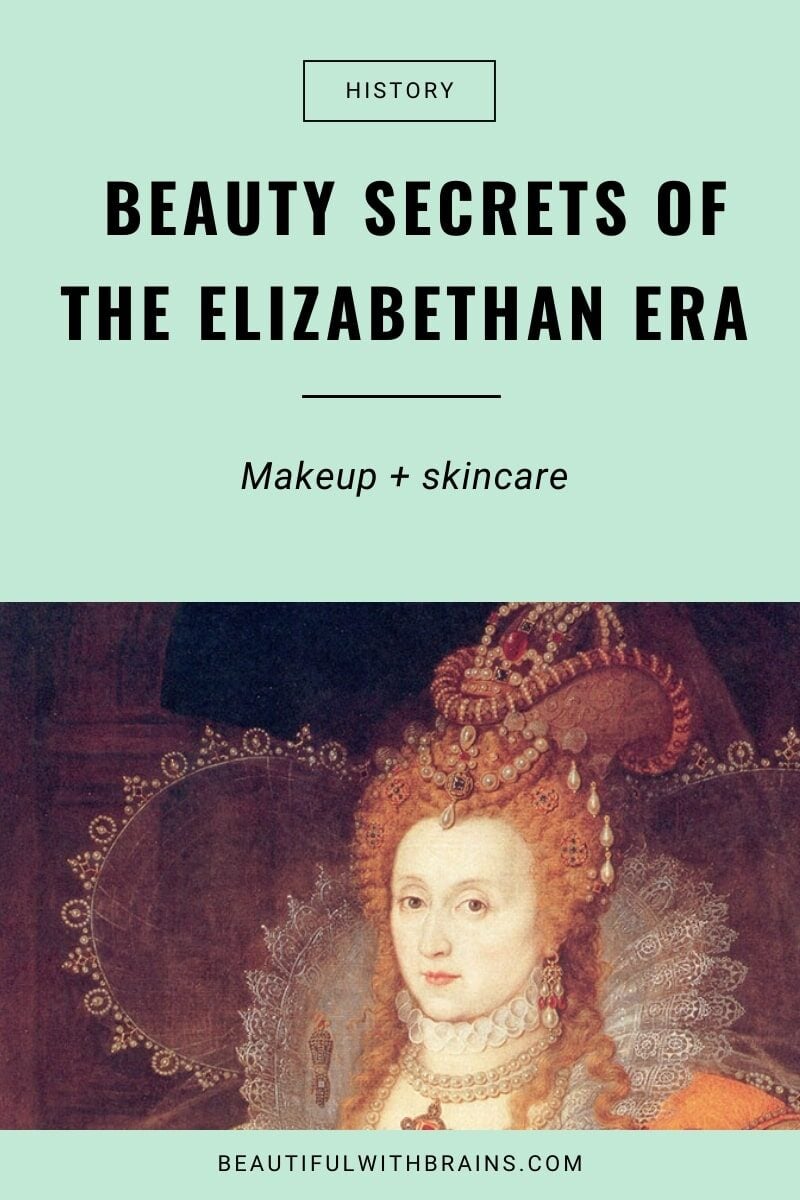
Pale, alabaster skin. Curly, red hair. Thin, arched brows. Elizabeth I, daughter of Henry XVIII and his second wife Anne Boleyn, perfectly personified the beauty ideal of the era.
All the women at court wanted to look like her. Here’s the lengths they went through to make that happen:
Face
Back then, a pale complexion was a sign of good health and prestige. The reason is simple: only rich women could afford to have fair skin. Poor ones worked for hours outside and developed a tan as a result.
To get the pale look, women (and men) used several different things: Ceruse (a foundation made with poisonous white lead and vinegar), sulphur, alum or tin ash.
Plus, they also used white eggs to fake a paler complexion and hide wrinkles (eggs have a tightening effects that made skin look smoother).
Eyes & Eyebrows
During the Elizabethan era, women used black kohl to rim their eyes and make them look darker. They also used Belladonna to enlarges pupils and make their eyes look larger and sparkly.
Eyebrows had to be thin and arched to create a high forehead (it was a sign of aristocracy). They achieved the look by plucking.
Cheeks & Lips
During the Elizabethan period, rouge cheeks and lips were very popular. To achieve them, women used plant (like madder, an Asian plant with red roots) and animal dyes (such as cochineal, a beetle) on the cheeks.
They also reddened their cheeks with a mixture of egg white and ochres. Other lip dyes were madder, cochineal or vermilion, a red pigment obtained from mercury sulphide.
Skincare
All that makeup women (and men) used to achieve a white complexion wreaked their skin. To get rid of blemishes, wrinkles, spots and freckles the Elizabethans would use rosewater, lemon juice or mixture of eggshells, alum, mercury and honey. The wealthy would also bathe in ass’s milk while washing the face with mercury.
Hair
Like pale skin, fair hair was fashionable, too. Women used different substances to dye or bleach their hair… even urine! Another way to get blonde hair was to use cumin seeds, saffron, oil and celadine.
It was also during this period that people began dying their hair red, the hair color of Queen Elizabeth I. Young women would wear their long hair down, and sweep it up once married, usually in a bun so that head coverings could easily be pinned to it.
Wigs were all the rage. They were used by women whose hair was growing thinner or by those who wanted their hair to be of a certain color. Some women were so desperate to have fashionable hair that they decided to completely shave their hair off and only wear wigs!
Both real and fake hair was often adorned with jewels and hair pieces. These were very expensive, so only rich women could afford them.
Men Hair & Beards
At the start of the Elizabethan era, men used to wear their hair short. But as the years went by, the fashionable hair length grew longer and longer. Long hair had to be curly. They achieved the look with hot irons to achieve and then used wax or gam to keep it in place.
Beards could be cut in lots of different shapes from round to square, from oblong to pointed. But they were long and kept in place with starch.

beauty and grooming have certainly evolved so much. now we have everything ready without the pain of DIY-ing everything 😀 i would love to have the luxury to bathe in ass’ milk tho
After reading this the only thing I can do is thanking God for being born in the XXth century…
thanks for sharing, this is interesting to read 🙂
.-= Jess´s last blog ..I’m being tempted by Ascience promotion! =-.
Xin, yes, we have certainly come a long way with them. Now we have lots of products that we can buy instead of making but what hasn’t changed is that we still go to great lenghts to achieve the ideal of beauty we have these days.
That sounds nice, doesn’t it? I wouldn’t mind that too. 🙂
Negra Cabreada, lol. I agree with you. We have some weird trends too but at least we don’t have to use those poisonous ingredients and weird homemade masks that didn’t work too well.
Jess, you’re welcome. I’m glad you enjoyed it. 🙂
great info really helped me on my study 😀
Bob, thanks. I’m glad it helped you.
Hello, as part of research I am doing I am required to “critique my sources”. Where did you get this information from? And, have you had any professions or experiences which have involved in depth analysis of this era etc. Basically, was this just for a one time blog post or have you had any background resource/course etc. with this part of history?
thank you!
Hi Hannah. I’m a history geek who loves the Tudor era so I read a lot of books about the subject. Unfortunately, I don’t remember which ones I used for this post. I have so many and this was written years ago. Sorry!